The technological, elegant and non-armored F-35 can carry out the same missions as the armored, rough and bad A-10 Thunderbolt II?
The fierce diatribe between Congress and the Pentagon on the plane that will have to play the future Close Air Support (in theory it should be just the F-35) that arose last year, it shows no sign of abating. The Air Force has always claimed that it has no other choice: it takes money to allocate to the F-35 program and the A-10's exit from the scene would save the Pentagon something like 4,2 billion dollars.
The Defense Department, however, seems to have all agreed. The A-10 (retired several times and always called up again) will remain in service at least until 2018, the year in which the comparative tests between the two systems will begin.
The tests - reads an official Pentagon statement - will reveal the capabilities of the F-35 in the "CAS" missions. It should be noted that these comparisons had already been foreseen, as happened in the past, for example, with the F-22.
The F-35 development timeline includes comparative tests with all the planes it will replace. The A-10 will be the first aircraft, then it will be the turn of the F / A-18 and so on. If the tests reveal deficiencies in the F-35, the Air Force will use all available resources to improve the JSF.
F-35, furtive and technological. A-10, born to fight
Invisible, agile, powerful, with fully integrated avionics. These are some of the characteristics of the JSF, the fifth-generation tactical fighter that entered service on 1 August with the Marine Corps. The Lightning-II will carry out missions of air superiority and tactical bombardment, replacing several aircraft, some of which have made the history of aeronautics. At the Joint Strike Fighter the daunting task of replacing 'sacred monsters' like the F-16, the F-18 Hornet, Tornado, Amx, Harrier and F-5.
The F-35 is also expected to replace the Fairchild-Republic A-10 Thunderbolt II in its role as Close Air Support. Specifically, the tactical support is carried out by aircraft with strong abilities to suppress enemy antiaircraft defenses and able to face opposing terrestrial forces in the proximity of those friends. These missions must necessarily be carried out by sturdy, extremely agile low-level aircraft, capable of pouring enormous firepower, collecting the enemy's blows and returning to the base even if heavily damaged. A task carried out even today, since the first flight took place in the 1976, from the A-10: a monstrous machine.
In the forecasts, the F-35 should replace it, giving the 'Fairchild' a well-deserved retirement. The latter, however, has been extended since the 1990, when the needs transformed the A-10 from next to the pension to the protagonist. According to a new forecast, in fact, the A-10 will remain in service at least until the 2018 (even if the date could be moved to the 2020 / 25), waiting for it to be replaced by the F-35 and the drones designed precisely for close air support.
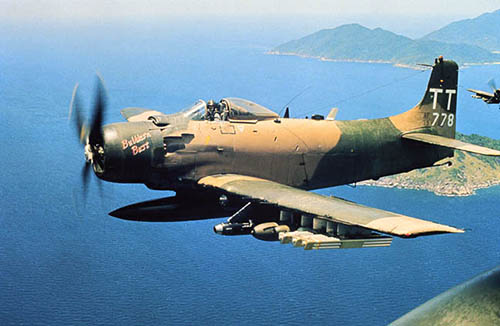 The history of close-up aircraft should make us think. In fact, the role of tactical support has almost always been played by aircraft deemed obsolete, slow and not in step with the times. Just think of the Douglas A-1 Skyrider, an aircraft entered into service in the 1947 and withdrawn into the 1968. It was slow and obsolete, but very robust. He could collect hundreds of hits from the enemy infantry, he could stay for hours on the operational area and transport an impressive arsenal thanks to his fourteen wing air piers. It was the perfect aircraft.
The history of close-up aircraft should make us think. In fact, the role of tactical support has almost always been played by aircraft deemed obsolete, slow and not in step with the times. Just think of the Douglas A-1 Skyrider, an aircraft entered into service in the 1947 and withdrawn into the 1968. It was slow and obsolete, but very robust. He could collect hundreds of hits from the enemy infantry, he could stay for hours on the operational area and transport an impressive arsenal thanks to his fourteen wing air piers. It was the perfect aircraft.
Same story for the A-10: repeatedly declared finished, but always called back to the front line until it is considered by the USAF the only specific aircraft for Close Air Support.
But why?
Meanwhile the context. The infantry support role is a specific task. The fighter flies just a few meters from the ground, so it is within reach of the small and large caliber weapons of the enemy, as well as of the anti-aircraft guns not to mention, finally, the Sam missiles. The aircraft must be able to continue to 'hammer' the enemy by performing multiple passes, staying for a reasonable period on the operational area, protecting its forces. Usually, the tactical support aircraft acts in very critical situations, with predominant enemy infantry and is the first to provide support and the last to leave the area (protecting for example a team being recovered). Therefore, armor plating of the aircraft is essential.
In close air support, where asymmetric combat reaches its highest peaks, invisibility (to radars), being stealth, holding the most sophisticated avionics, counts for almost nothing, considering that you can fool a missile, but certainly not the bullets from 23 mm or an Ak. And beyond theory, history teaches: the United States has always entrusted close air support to obsolete aircraft compared to the period.
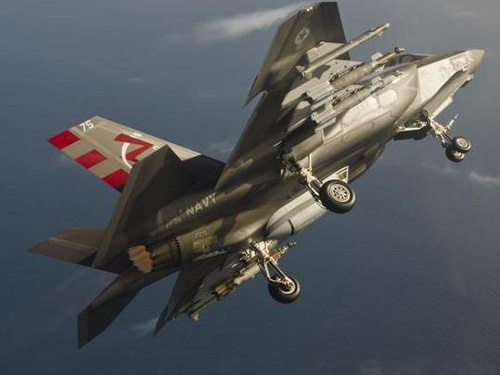 But let's look at the two aircraft. Why, the F-35, can hardly replace the A-10?
But let's look at the two aircraft. Why, the F-35, can hardly replace the A-10?
Here are some examples. The A-10 was designed for one purpose: to survive. It is heavily armored, with armored plates to protect the vital parts of the aircraft. The pilot is protected by a bulletproof roof and is wrapped in a sort of armored titanium “tank” that weighs about 600 kg. The A-10 has been designed to withstand 23 mm and some 57 mm cannons. It can fly with a damaged and partially destroyed wing, a single engine, a single rudder, a single wing. It can fly with the damaged hydraulic system, thanks to reserve mechanical controls. Its downward bent wingtips increase lift at low speeds. The main wheels of the trolley protrude from the gondolas when it is retracted: a further guarantee of survival even when the trolley cannot be extended.
The F-35 is a fifth-generation tactical fighter. It's all about invisibility and avionics, not comparable with any other existing fighter (F-22 excluded). It was designed to impose aerial supremacy for the next 50 / 60 years, engaging the enemy (almost exclusively) beyond the visual range.
The problem, however, is precisely this: one wonders, what can being "stealth" be in a close combat, almost melee, where armor and firepower are the main and determining role in missions ?
The F-35 cell was not designed to withstand the fire of the infantry nor to survive the fire of 23 guns. JSF was born to be elusive and efficient, certainly not due to the dirty war of Close Air Support.
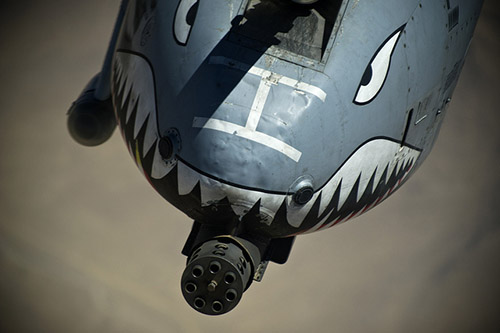 The A-10 has been designed around the seven-barreled GAU-8 Avenger cannon, the most powerful airborne tactical weapon on the planet. It is a Gatling type cannon from 30 mm with two firing rates: 2100 or 4200 strokes per minute and can be brought to the maximum firing rate in 0,55 seconds. The ammunition tank carries a maximum of 1350 shots. It is capable of destroying a tank at almost 7 km away.
The A-10 has been designed around the seven-barreled GAU-8 Avenger cannon, the most powerful airborne tactical weapon on the planet. It is a Gatling type cannon from 30 mm with two firing rates: 2100 or 4200 strokes per minute and can be brought to the maximum firing rate in 0,55 seconds. The ammunition tank carries a maximum of 1350 shots. It is capable of destroying a tank at almost 7 km away.
The F-35A is equipped with a Gatling cannon from 25 mm GAU-22 / A with four rotating rods, carried internally (only in version A, will the B and C carry it externally). It is capable of firing three thousand shots per minute, with a range of 180 shots. Beyond the ability to penetrate ammunition (lower than the Avenger), the standard equipment of the F-35A is less than almost 10 times compared to the A-10.
The A-10 has ten sub-wing pylons and is one of the most heavily armed aircraft in the US Air Force. It can carry almost 7 thousand and 500 pounds of weapons. The F-35A can carry two air-to-air and two air-to-ground missiles internally. You are the sub alari pillars. It can carry just over eight thousand kilos of equipment.
The A-10 has two TF34 turbo fans that allow it a speed of 834 km / h and a range of 460 km. The F-35A is equipped with a Pratt & Whitney F135-PW-100 with afterburner that allows it a maximum speed of 1900 km / h and a range of one thousand km.
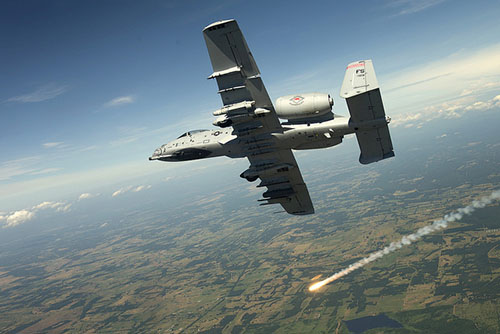 It is impossible to make a technological comparison between the two aircraft. The F-35 is probably the most advanced fighter in the world (after the F-22 Raptor and Russians permitting) and was designed for aerial supremacy with the ability to engage and destroy enemy aircraft before it is even discovered by these last.
It is impossible to make a technological comparison between the two aircraft. The F-35 is probably the most advanced fighter in the world (after the F-22 Raptor and Russians permitting) and was designed for aerial supremacy with the ability to engage and destroy enemy aircraft before it is even discovered by these last.
It was equipped with the most advanced technology available at a cost (last July) ranging from 130 to 100 million dollars depending on the versions. The price will fall in the coming years, stabilizing, according to Lockheed, at around 80 million dollars per specimen. The A-10, designed in the 70 years, could not operate in scenarios where aerial supremacy had not previously been imposed: it would be a very easy prey. The project was born for the tactical support and the destruction of tanks with a cost of just under 12 million dollars per specimen.
Staying in service until the 2020 / 25 (updates could also drag it to the 2040), the A-10 could be the first fighter in the world to fly for 50 years and more. This says a lot about the capabilities of the aircraft, designed to support troops on the ground.
The F-35 was designed to excel in a highly technological context, impose air supremacy and perform tactical bombing.
The A-10, instead, to collect hits and hammer the enemy: both, in the near future, could perform combined operations in the same mission, with a technological gap between the two aircraft of just fifty years.
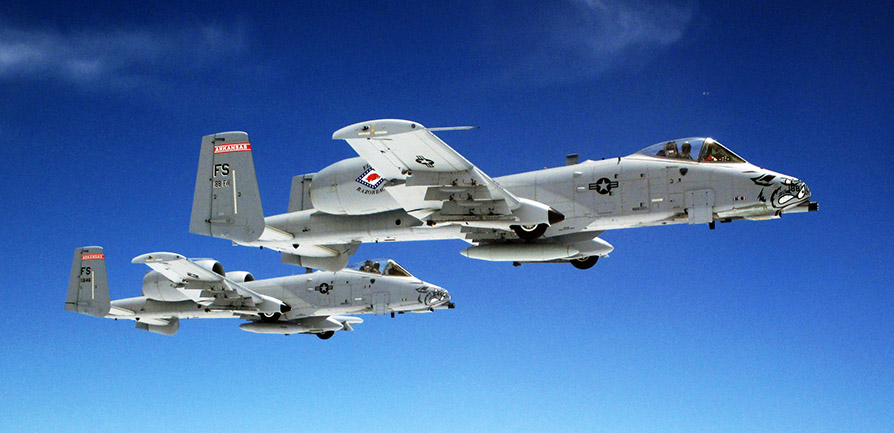
(photo: Lockheed Martin / US Air Force)











